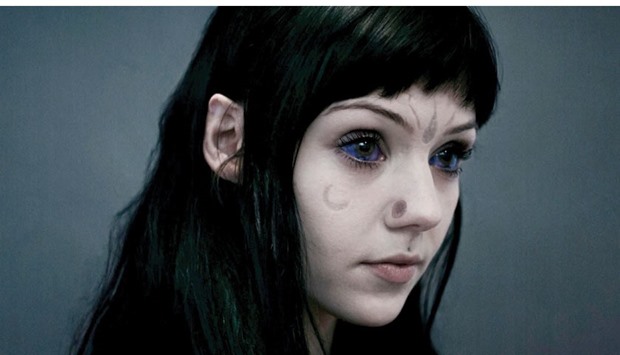US tattoo artist Luna Cobra got the idea of colouring the whites of the eyes while attending a body-art convention with his colleague Shannon Larratt, who had photoshopped his eyes blue.
Larratt was a fan of Dune, an epic science fiction written by Frank Herbert, and had digitally altered his own picture to look like the Fremen, the all-blue-eyed residents of the desert planet of Arrakis.
“I asked Shannon if he would be interested in making his eyes permanently blue if I figured out a way. He laughed and said, only if there were two other people to try with him,” Cobra said.
Cobra found him two other friends and after intensive research, he performed the first “eyeball tattooing” for real.
A few months later, CSI: New York, a popular crime TV series in the United States, made “a mock-up story based on the procedure.”
“The rest is history,” Cobra told dpa in an interview.
The procedure, which takes just a few minutes, is as simple as it is perilous and apparently painful.
The white part of the eyeball, known as the sclera, is “tattooed with a solid colour or mix of colours” in what is described as a hand-poking procedure, an old technique in which a needle with ink at the tip is poked into the skin.
With the help of a hypodermic syringe, the ink is “placed safely” in a super-thin layer of the sclera, between its mucous-covered outer membrane and the hard inner white of the eye, he said.
Since the first experiment, he has “streamlined the procedure with better technique and materials,” insisted Cobra, who has been working in “body art” for more than 22 years.
He received his first tattoo at the age of 15, after being fascinated with the photos of body art and tattoos by various indigenous tribes in National Geographic magazines at his school library.
Apart from piercing and tattoos, his services now include surgical body modifications, like ear pointing, cartilage removal, tongue splitting, horn and other implants in the body, scarifications and cosmetic changes like constructing dimples and fixing scars.
Since inventing the procedure in 2007, Cobra said he has performed eyeball tattooing on hundreds of clients throughout the world.
He insisted there has not been a single complication with his clients.
But there are reports of such procedures going wrong, with some people even losing their eyesight when it was performed by novice tattooists.
Cobra blamed this on “people with very limited basic education, who see this just as a cool thing to do and do not care for their bodies.”
“In a way, I am responsible. It was my invention. But I have always told people never to do this,” said Cobra, who recently moved from Paris to Melbourne, Australia to start a new studio.
“It’s sad for me, because it’s something I created to use as an art for people to express themselves... so that they can feel comfortable with their body and their place in the world.”
In February, the government of the Australia state of New South Wales effectively legalised the eyeball tattoo by defining it as a “skin penetration procedure.” The state wanted to regulate the practice so that it would be performed in a clean and safe environment.
“Eyeball tattooing involves much the same risk of transmission of blood-borne viruses as other forms of tattooing, which is why we moved to tighten the regulations,” Jillian Skinner, the New South Wales health minister, said.
Luke Arundel, a Melbourne-based senior optometrist, said the practice is “painfully dangerous.”
“Cobra might have had a good record so far, but at the end of the day, it’s the eyes, the most sensitive organ of our body.
“Sticking things into an eye is a very risky business, no matter how safe you are. There is very little margin of error,” he told DPA.
He said the ink dye had to be injected into a membrane less than half a millimetre thick.
“It’s a sight-threatening procedure that could lead to severe infection, retinal detachment and other problems,” he said, adding in the risk people could suffer from chronic headache, ulceration around the area of penetration and severe sensitivity to the light.
“Also, there is no guarantee that it will not develop complications later in life. Eye doctors in the West have said that there could be granulomatous inflammation and cancerous changes, which takes time.”
Despite all the risks, 30-year-old Kylie Lee Garth had her eyeballs tattooed two years ago by Luna Cobra.
The whites of her eyes are now shiny sea-foam green.
“It’s just a natural progression. I liked the way it looked and I wanted this modification. There was no risk involved. I knew the procedure. I knew he had tweaked the method in the past 10 years to the safest possible way and I had witnessed that,” she said.
“I wanted a light colour, something very subtle. We played around with a bunch of light pastel colours.”
The process was “scary, mentally,” said Garth, a New Zealander who herself is a professional body piercer and a rookie tattooist. “The procedure itself was fine. I felt the cold of the needle. It was a bit scratchy at first. The ink was in blots the first day, but when I woke up the next day, my eyes were blue,” she said.
“It was the most exciting day of my life.” —DPA

RISKY? Eye tattoo specialist Luna Cobra claims it is all fine, but many medical specialists warn it is dangerous.
